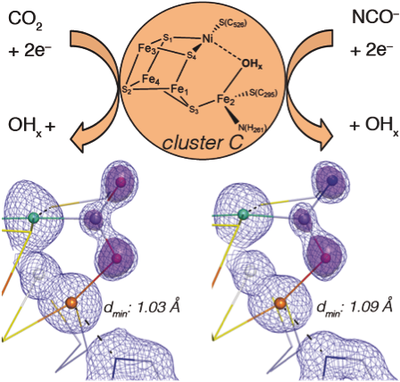A blue-print for the activation of Carbon Dioxide

In their newest paper published in Angewandte Chemie, Jochen Fesseler, Jae-Hun Jeoung and Holger Dobbek describe in unprecedented details how the activation of CO2 and its isoelectronic analogue NCO– is achieved at a complex biological metal center. Carbon monoxide dehydrogenase (CODH) employs a [NiFe4S4] cluster (cluster C) to bind and activate CO2, which is subsequently split into CO and water. By using x-ray crystallography, the authors were able to describe the clusters geometry with bound substrate CO2 and its inhibitor NCO– under turnover conditions at true-atomic resolution (dmin < 1.1 Å).
„Our insights will be of great help for synthetic inorganic and theoretical chemists“, explains Jochen Fesseler, lead author of the study. “By using our high-resolution structures as a blue print, complexes with comparable catalytic power could be developed for large-scale CO2 conversions in the future.“
Citation:
Jochen Fesseler, Jae-Hun Jeoung, Holger Dobbek (2015): “How the [NiFe4S4] Cluster of CO Dehydrogenase Activates CO2 and NCO−.“
Angew. Chem. Int. Ed..doi: 10.1002/anie.201501778
http://dx.doi.org/10.1002/anie.201501778 (english)
